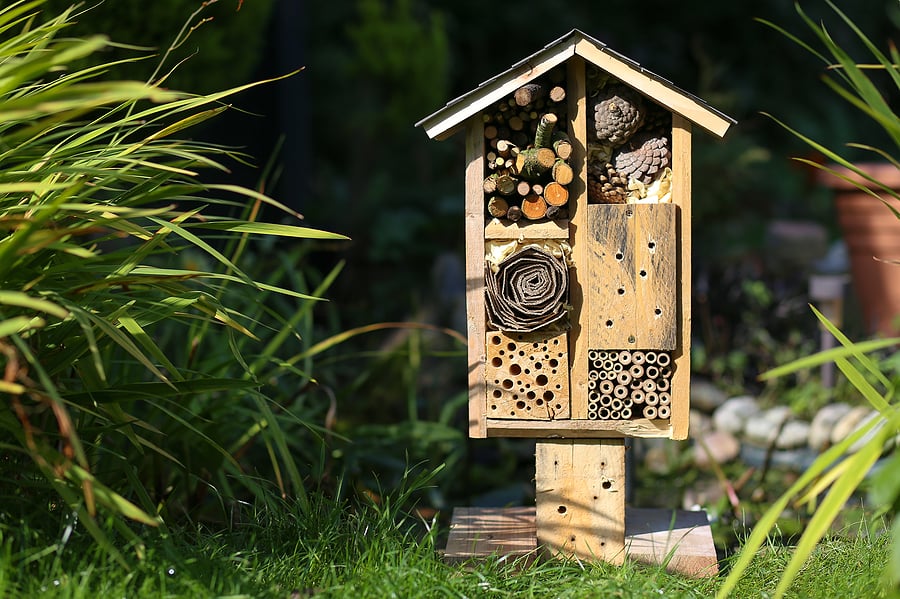World Bee Day: 7 ways to support bees in your garden
Bees are a vital part of the food chain, but they’re under threat – here are some easy ways to help bees thrive in your garden.
It’s World Bee Day (May 20), and we’re all being encouraged to ‘Bee Engaged’ with our buzzing black and yellow friends.
Bees are one of the hardest working creatures on the planet, and honey bees in particular fly around 55,000 miles to collect enough nectar to make just one pound of honey. Those hard workers are vital for maintaining our food supply – it’s estimated a third of our food relies on pollination, mainly by bees.
But Friends of the Earth (FoE) warns bees are under threat of extinction for many reasons, including habitat loss – wildflower meadows have all but disappeared in recent years – climate change, toxic pesticides and disease, which have all led to nearly one in 10 of Europe’s wild bee species facing extinction.
Here’s how you can support bees in your own garden…
1. Plant bee-friendly flowers…
 It doesn’t matter if your outdoor space is a tiny balcony or a big open green, you can always plant up a few pots – even tomato tins with a hole in the bottom for drainage will work – with flowers for bees to feed on. Avoid modern ornamental hybrids or cultivars, bred for their large blooms and colours, as most produce no nectar or pollen. Instead, focus on flowers bees love, including lavender, alliums, honeysuckle, heather, buddleja, foxgloves and snapdragons.
It doesn’t matter if your outdoor space is a tiny balcony or a big open green, you can always plant up a few pots – even tomato tins with a hole in the bottom for drainage will work – with flowers for bees to feed on. Avoid modern ornamental hybrids or cultivars, bred for their large blooms and colours, as most produce no nectar or pollen. Instead, focus on flowers bees love, including lavender, alliums, honeysuckle, heather, buddleja, foxgloves and snapdragons.
2. …and plant through the seasons
Bees need nectar sources throughout the year, so think about planting flowers that bloom and provide pollen at different seasonal points. Trees can particularly help with this – try small trees like hazel, holly and pussy willow which will help bees at different times of the year. Ivy is a top bee food in autumn too.
3. Grow fruit, vegetables and herbs
 Bees love fruit and veg, and they’ll help pollinate them for you. FoE suggests growing French, runner and broad beans, aubergines, onions and peppers, as well as apples, pears, plums, blackberries, strawberries and raspberries. The more variety, the better for the bees. And a herb border of thyme and rosemary will help too.
Bees love fruit and veg, and they’ll help pollinate them for you. FoE suggests growing French, runner and broad beans, aubergines, onions and peppers, as well as apples, pears, plums, blackberries, strawberries and raspberries. The more variety, the better for the bees. And a herb border of thyme and rosemary will help too.
4. Put up a bee hotel

Support solitary bees by providing them with nesting shelter, via a bee hotel. Place one (or more) on a wall or fence in your garden. You can even make one out of short lengths of bamboo canes tied together.
5. Have a hive in your garden

If you have a big garden, you may be able to help a local beekeeper by providing space for a hive or two. Contact your local beekeeping association to let them know you can help. Or take steps to become a beekeeper yourself!
6. Don’t cut your lawn as often
The Royal Horticultural Society (RHS) says it can help bees if you allow lawn ‘weeds’ to flower by cutting the grass less often. It can also help to mow grass in the evening. Cutting less often and less closely will help give pollinators places to feed and shelter among the grass.
7. Avoid pesticides
To keep your garden as welcoming as possible to bees, gardeners should also avoid using pesticides wherever possible, and according to the RHS, never spray open flowers.
The Press Association
Latest posts by The Press Association (see all)
- In Pictures: Party stalwart kept New Labour in touch with traditional supporters - November 21, 2024
- 6 easy indoor exercises to try this winter – and why they are good for you - November 19, 2024
- Martin Clunes: I can’t afford to retire – I’ve got too many horses - November 19, 2024
- How to avoid plant losses, flowering disappointments and container catastrophes - November 17, 2024
- John Lewis Christmas ad stars sister in last-minute dash back in time - November 14, 2024





















